Table of Contents
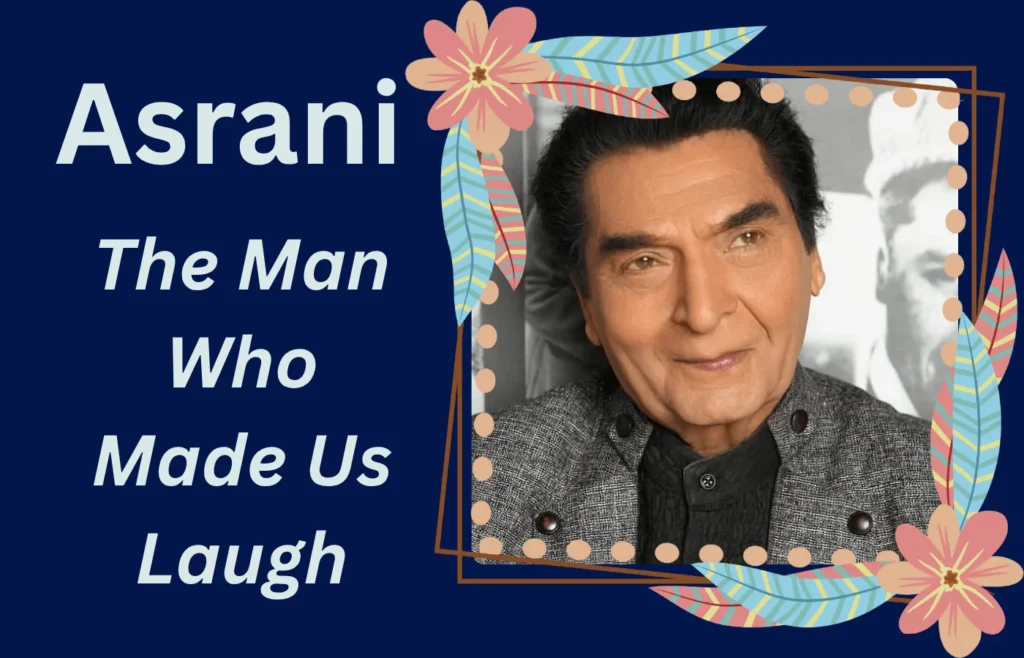
Introduction – The Man Who Made India Laugh
There are few names in Indian cinema that can instantly evoke laughter, nostalgia, and warmth — and one of them is Govardhan Asrani, better known simply as Asrani. For over five decades, he stood as a pillar of comedy, delivering impeccable timing, infectious energy, and a brand of humor that felt effortless yet deeply human. From the unforgettable “Angrezon ke zamaane ke jailor” in Sholay to the kind-hearted supporting roles in films like Chhoti Si Baat and Bawarchi, Asrani became an inseparable part of Bollywood’s golden era of laughter.
Born with a natural flair for mimicry and observation, Asrani transformed everyday situations into comedy that connected across generations. His characters often reflected the common man — flawed yet lovable, timid yet witty — mirroring the pulse of Indian society during times of change. What made him extraordinary was not just his humor, but his ability to blend it with emotion, making audiences both laugh and care.
On 20 October 2025, the curtains fell on this remarkable life. Asrani passed away at the age of 84 in Mumbai after a prolonged illness, marking the end of an era that had shaped the soul of Indian comedy. His passing left millions of fans heartbroken, as the film industry bid farewell to a legend who had given voice and joy to countless moments on screen. Yet, even in his absence, his legacy continues to live through the characters, laughter, and lessons he left behind.
As we revisit Asrani’s journey — from a young dreamer in Jaipur to one of Bollywood’s most beloved comedic icons — we discover not just an actor, but a storyteller whose craft was rooted in authenticity and human connection.
Early Life & Origins – The Making of a Performer
Childhood in Jaipur: Humble Beginnings
Govardhan Asrani was born on 1 January 1941 in Jaipur, Rajasthan, into a middle-class Sindhi family. His father ran a small carpet-trading business, while his mother was known for her warmth and love of music — qualities that shaped young Asrani’s sensibilities. Growing up in the vibrant lanes of Jaipur, he absorbed the local theatre culture, folk performances, and storytelling traditions that would later become the foundation of his acting craft.
Even as a child, Asrani showed a natural gift for mimicry and humor. Friends and teachers recalled how he could effortlessly imitate voices, dialects, and gestures of people around him, turning everyday situations into impromptu performances. This early instinct for observation and timing would one day define his screen persona.
Education and Early Interests
Asrani studied at St. Xavier’s School and later at Rajasthan College, where he balanced academics with a growing fascination for drama. He often participated in college plays and cultural festivals, finding in them a space to express his wit and creativity. Yet, the idea of becoming an actor in films seemed distant — especially for someone from a non-film background in the 1950s.
Still, Asrani’s determination to entertain kept growing. After graduation, he briefly assisted his father in business, but his heart was elsewhere — in the world of performance. He began exploring opportunities in local theatre groups and eventually took up small voice-artist assignments at All India Radio, Jaipur. These experiences taught him voice control, rhythm, and modulation — skills that would become invaluable in his film career.
A Leap of Faith: Journey to the Film and Television Institute of India
Realizing his true calling, Asrani decided to pursue formal training in acting. He moved to Pune to enroll at the Film and Television Institute of India (FTII) — an institution that was nurturing the next generation of Indian cinema talents. This decision marked a turning point in his life. At FTII, Asrani refined his understanding of screen presence, dialogue delivery, and emotional expression.
It was here that he interacted with future legends of Indian cinema, building relationships and a professional grounding that would later open the doors to Bollywood. His training gave him not only the technical finesse of an actor but also the confidence to face an industry that was both glamorous and demanding.
Seeds of a Dream
By the time Asrani completed his training, the dream of cinema had become his reality. He moved to Mumbai — the beating heart of Indian films — armed with talent, discipline, and an unshakeable belief in his craft. The road ahead would not be easy, but his early years in Jaipur had already taught him the value of patience and perseverance.
These formative experiences shaped Asrani not just as an actor but as an artist rooted in sincerity. The lessons of his youth — observation, adaptability, and humility — became the very traits that later endeared him to millions across India.
Entry into Films & Struggle Years
The First Steps in Cinema
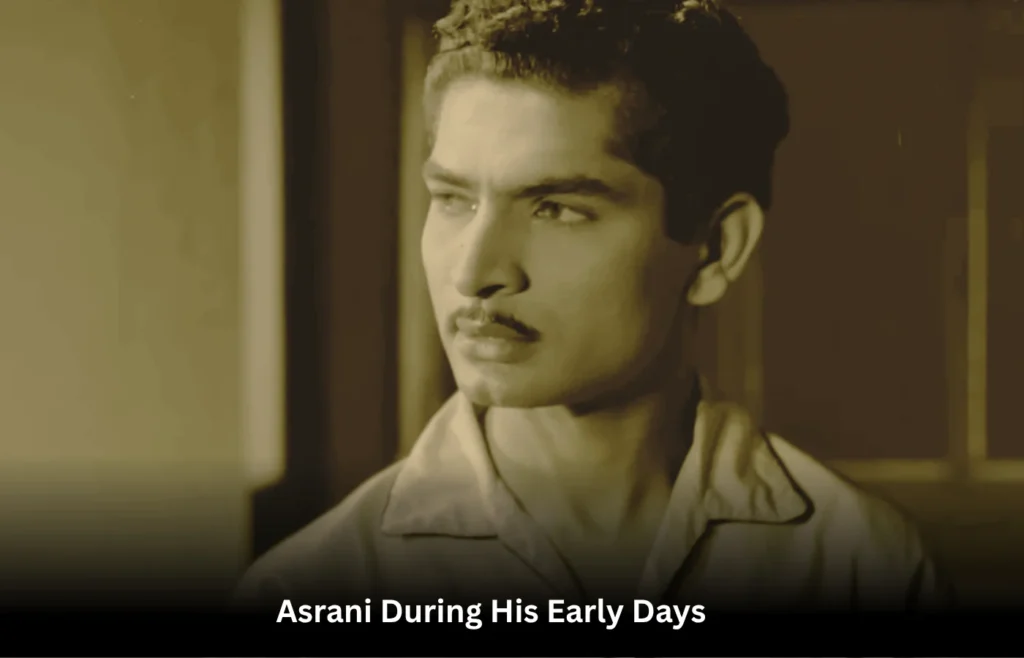
After graduating from the Film and Television Institute of India (FTII) in the mid-1960s, Asrani arrived in Mumbai, a city that was both a dreamland and a test of endurance for aspiring artists. With little financial security and no industry connections, he began his journey by visiting studios, waiting outside production offices, and attending countless auditions.
His first break came in Gujarati cinema with the film Kalapi in 1966, where he played a small yet memorable role. This debut, though modest, helped him find his footing and introduced him to the rhythm of the film industry. Soon after, he appeared in Hindi cinema with Hare Kaanch Ki Choodiyan (1967), marking the start of what would become an extraordinary career spanning over five decades.
Early Challenges and Uncertain Days
The late 1960s were not easy for newcomers in Bollywood. It was a time when leading roles were dominated by established stars, leaving limited space for fresh faces. Asrani found himself taking on minor parts — clerks, friends, and background characters — often with only a few lines of dialogue.
Despite the lack of visibility, he never treated any role as small. Each performance, no matter how brief, was a chance to prove his ability. He paid close attention to his timing, gestures, and expressions, quietly carving an identity that audiences would soon recognize. Behind the laughter that he later became known for was a deep understanding of character and emotion, cultivated during these formative years.
Persistence Amid Rejection
Asrani’s struggle was not just professional but also personal. With limited income, he lived in small rented rooms, sometimes skipping meals to save money for travel or photographs to submit to casting directors. Yet, he remained undeterred. His unwavering faith in his craft and his disciplined training from FTII gave him the mental strength to keep going.
He would often recall in interviews that these were the years when he truly learned resilience — the art of standing tall after every rejection. His perseverance eventually caught the attention of filmmakers who saw beyond the minor roles and recognized his comedic potential.
The Turning Point: Finding His Space
By the early 1970s, Asrani began to receive roles that showcased his natural comic timing and expressive range. His breakthrough came through collaborations with filmmakers who appreciated subtle humor and relatable characters. These roles allowed him to evolve from a background performer into a recognizable screen presence.
Audiences started noticing the actor who could make them laugh without exaggeration — who could turn a simple situation into a moment of pure joy. This blend of simplicity, timing, and sincerity would soon make him one of the most sought-after comedians of Indian cinema.
Asrani’s early struggles laid the foundation for a career built on authenticity and humility. Every small part he played during those years added a layer to his artistry. When fame eventually arrived, he carried with him the wisdom of those lean years — a reminder that even in the glitz of Bollywood, true success is often born from perseverance, patience, and an unbreakable belief in one’s dream.
Rise to Prominence & Signature Style – Crafting Laughter with Heart
The Decade of Recognition: 1970s and Beyond
The early 1970s marked a golden phase in Asrani’s journey — the years when his perseverance blossomed into recognition. The Indian film industry was evolving, embracing realism alongside entertainment, and Asrani fit perfectly into this changing landscape. Directors such as Hrishikesh Mukherjee, Gulzar, and Basu Chatterjee sought actors who could infuse authenticity into everyday roles, and Asrani became one of their favorite choices.
Films like Aaj Aur Kal (1971), Bawarchi (1972), and Chhoti Si Baat (1975) highlighted his effortless ability to blend humor with subtle emotion. He wasn’t merely playing the comic relief; he was making audiences see themselves in his characters — the office worker, the friend, the man-next-door who found humor in life’s struggles. His performances carried both wit and warmth, resonating deeply with middle-class India.
Iconic Role in Sholay: The Jailor Who Became a Legend
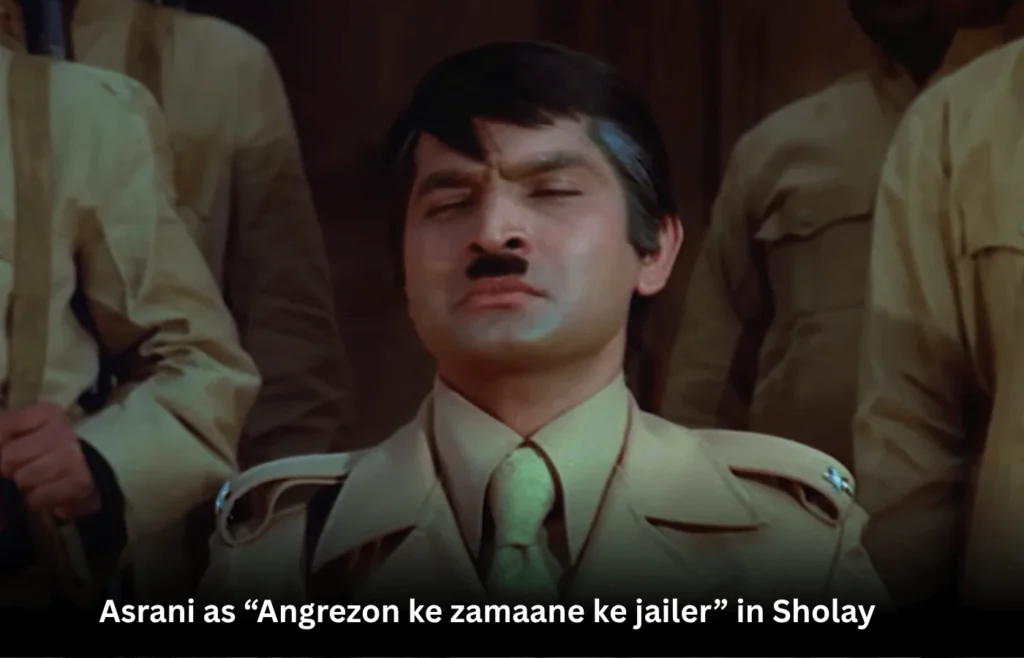
No discussion about Asrani’s career can ever be complete without mentioning his iconic portrayal of the eccentric jailor in Ramesh Sippy’s 1975 masterpiece, Sholay. In a film dominated by larger-than-life heroes and intense drama, Asrani’s brief appearance became unforgettable. His exaggerated salute, twitching moustache, and the immortal line — “Hum angrezon ke zamaane ke jailor hain” — became cultural landmarks in Indian cinema.
That single sequence captured the essence of his brilliance: the ability to command attention with minimal screen time. It was not just comedy; it was satire — a sharp, playful mockery of authority, delivered with impeccable timing and flair. Even decades later, the Sholay jailor remains one of the most quoted and loved comic characters in Bollywood history.
The Hallmarks of His Comedy
Asrani’s comedic genius was rooted in timing, adaptability, and emotional intelligence. He had an instinct for rhythm — knowing exactly when to pause, when to exaggerate, and when to underplay. His facial expressions could shift seamlessly from innocence to mischief, turning ordinary dialogue into moments of laughter.
He was also a master of voice modulation. Whether playing a nervous clerk, a cunning assistant, or a pompous officer, Asrani used his voice like an instrument — sometimes soft and trembling, sometimes exaggerated and booming — always perfectly tuned to the mood of the scene.
What truly set him apart was his ability to adapt. Unlike many comedians of his era who relied on repetitive styles, Asrani’s humor evolved with time. He could switch between slapstick, situational, and character-driven comedy, making him relevant across generations. His performances never mocked others; instead, they celebrated the quirks and contradictions of human nature.
Standout Performances Across Decades
Over the years, Asrani delivered numerous memorable performances that showcased his versatility:
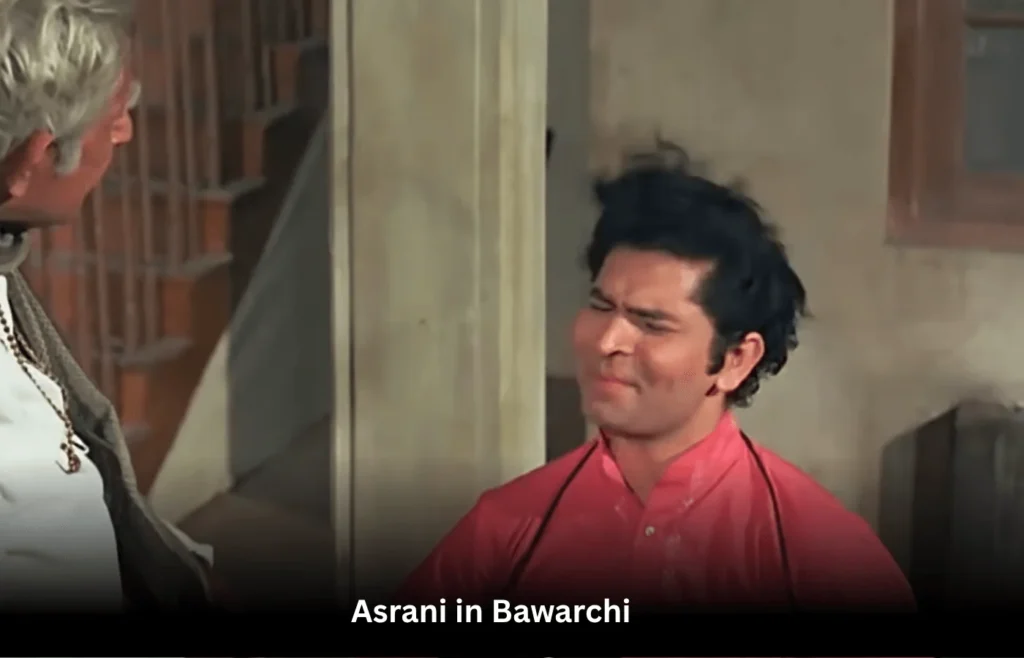
- Bawarchi (1972): As the confused but lovable house member, his comic timing complemented Rajesh Khanna’s calm charm, creating delightful family humor.
- Chhoti Si Baat (1975): His portrayal of a nervous, bumbling friend perfectly captured the innocence of the era’s middle-class struggles.
- Sholay (1975): The iconic jailor — a performance that transcended screen time to become a part of pop culture.
- Chala Murari Hero Banne (1977): His turn as a struggling actor mirrored his own early life, blending humor with touching self-reflection.
- Hera Pheri (2000): Decades later, Asrani proved his timelessness, bringing laughter to a new generation with his quirky supporting role.
Beyond Comedy: The Actor Within
While celebrated for his humor, Asrani was far more than a comedian. He brought emotional depth to his roles — the vulnerability of a man caught between laughter and reality. His characters often revealed the insecurities of ordinary life, wrapped in humor that felt healing rather than mocking.
This rare blend of comic rhythm and human understanding made Asrani a legend. He wasn’t just performing for laughs; he was showing audiences how to smile through life’s imperfections. And in doing so, he carved a permanent space in the hearts of millions.
Career Highs & Milestones
Govardhan Asrani’s career stands as one of the most extensive and versatile journeys in Indian cinema. Spanning over five decades and more than 350 films, his professional timeline reflects not only his unmatched talent but also his resilience and adaptability in an ever-changing industry. From his early days as a supporting comic actor to becoming one of Bollywood’s most recognizable faces, Asrani carved out a space that was uniquely his own — blending humor, humility, and a deep understanding of character.
The Golden Era: The 1970s Peak
The 1970s were undoubtedly the most defining years of Asrani’s illustrious career. During this time, Bollywood’s cinematic landscape was dominated by powerful storytelling and unforgettable performances — and Asrani became the heartbeat of comic relief in many of these timeless classics.
He began the decade with roles in Mere Apne (1971), Bawarchi (1972), and Aaj Ki Taaza Khabar (1973), earning praise for his effortless humor and impeccable timing. However, his performance as the eccentric jailor in Sholay (1975) catapulted him into stardom. With his exaggerated British-accented dialogue, “Hum Angrezon ke zamaane ke jailor hain,” he created a character that would live forever in the collective memory of Indian audiences.
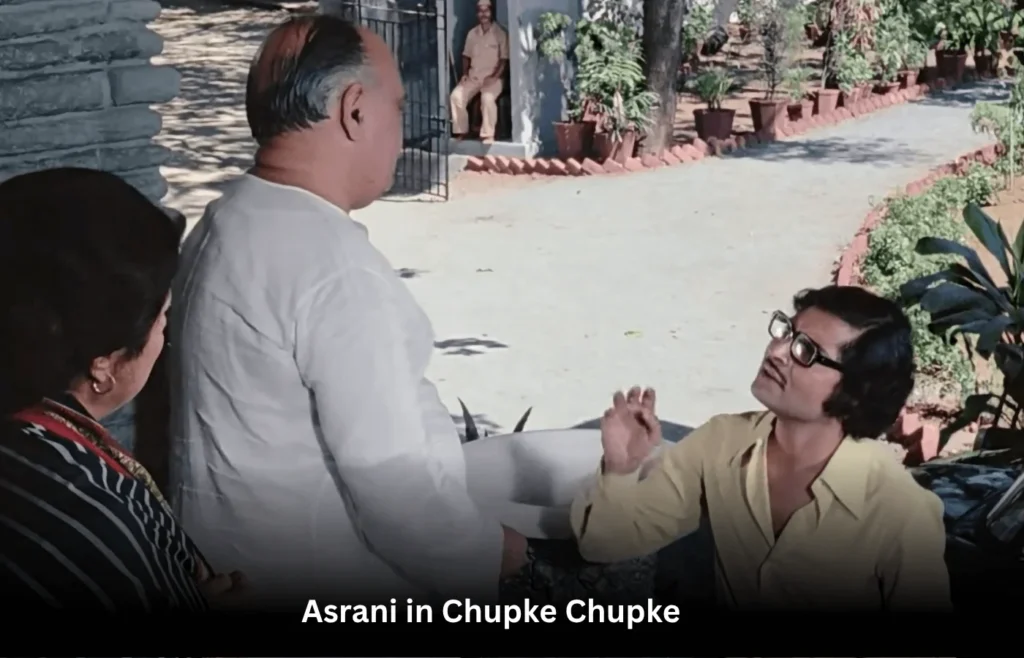
This phase marked Asrani’s evolution from a promising newcomer to a certified comic legend. His roles in Chupke Chupke (1975), Parichay (1972), Abhimaan (1973), and Roti (1974) showcased his rare ability to balance humor with emotional nuance. He wasn’t just a comedian — he was an actor who understood rhythm, subtlety, and the human condition beneath the laughter.
Sustaining Stardom: The 1980s and 1990s
Asrani’s success didn’t fade with the changing times. While the 1980s introduced a new wave of commercial cinema, he continued to evolve, appearing in both serious and comic roles. His performances in Chhoti Si Baat (1976), Gol Maal (1979), and Khoobsurat (1980) carried forward the legacy of intelligent, situational comedy that appealed to all age groups.
By the late 1980s and 1990s, as slapstick humor gained popularity, Asrani proved his versatility once again. In Dil (1990), Judwaa (1997), and Himmatwala (1983), he adapted to the new cinematic tone without losing his signature charm. His chemistry with leading stars such as Amitabh Bachchan, Rajesh Khanna, and later Govinda and Salman Khan, showed that his humor transcended eras and generations.
Throughout these decades, Asrani became a constant figure of laughter and warmth — someone who could be counted on to bring lightness even in intense narratives.
Beyond Acting: Direction and Writing
While audiences primarily remember him for his acting, Asrani’s creative pursuits extended beyond the camera. In 1977, he directed and wrote Chala Murari Hero Banne, a semi-autobiographical film inspired by his real-life journey — from his days of struggle in the Film and Television Institute of India (FTII) to his eventual fame in Bollywood.
The film not only reflected Asrani’s understanding of cinematic structure but also highlighted his ability to tell personal stories with humor and authenticity. His direction displayed a sensitivity toward both characters and storytelling — an extension of his deep artistic sensibility.
Adapting Through Changing Times
The late 1990s and early 2000s brought another wave of transformation in Indian cinema. New comedians like Johnny Lever and Paresh Rawal emerged, yet Asrani continued to remain relevant. His performances in Hera Pheri (2000), Malamaal Weekly (2006), Bhagam Bhag (2006), and Deewane Huye Paagal (2005) reintroduced him to a younger generation of audiences.
Unlike many of his contemporaries who faded from the spotlight, Asrani adapted gracefully — embracing television, stage performances, and guest appearances in modern films. His humility and professionalism made him a respected figure among newer actors and directors alike.
His ability to blend the old-world charm of classic comedy with the energetic style of modern humor ensured that his work remained timeless. Whether portraying a quirky school principal or an eccentric neighbor, Asrani’s screen presence carried the same sincerity that had defined his early days.
A Lifetime of Achievements and Recognition
Throughout his journey, Asrani was honored with several awards, including the Filmfare Award for Best Comedian and multiple lifetime achievement honors for his contribution to Indian cinema. However, his greatest recognition came from the audience — generations who grew up watching his films and still quote his dialogues with affection.
By the time of his passing in 2025, Asrani had become not just a comedian, but an institution of humor and character acting. His career reflected the evolution of Bollywood itself — from black-and-white classics to the digital era — and through it all, he remained a symbol of warmth, laughter, and dedication.
Impact & Legacy – The Enduring Imprint of Asrani
Shaping Popular Culture Across Generations
Asrani was more than just a comedian — he was a cultural touchstone in Indian cinema. His characters, dialogue delivery, and unique expressions became part of the social lexicon, quoted and remembered long after the films’ releases. His famous remark, “Hum Angrezon ke zamaane ke jailor hain!” from his role of the incompetent jailor in Sholay (1975), for example, has become a colloquial term for authoritative persons with a humorous twist. Similarly, his work in films like Chupke Chupke (1975) and Bawarchi (1972) made subtle comedy — rooted in situational humor and relatable characters — a staple of Bollywood storytelling.
Asrani’s influence transcended cinema. His timing, mimicry, and style inspired television comedy, stage performances, and stand-up acts for decades. Even today, mimicry artists and social media content creators pay homage to his expressions and mannerisms, demonstrating the timeless quality of his craft. His humor was never fleeting; it resonated because it reflected the quirks, awkwardness, and warmth of ordinary life, making audiences both laugh and identify with his characters.
A Mentor and Inspiration for Fellow Actors
Beyond his impact on audiences, Asrani played a significant role as a mentor and inspiration for peers and upcoming performers. Generations of comedians, including Johnny Lever, Paresh Rawal, Rajpal Yadav, and others, have cited Asrani’s comic timing, voice modulation, and expressive body language as foundational to their own performances. He demonstrated that comedy was not just about punchlines or exaggerated antics but about precision, observation, and emotional resonance.
Peers and collaborators often highlighted his humility and professionalism. Despite his iconic status, Asrani remained approachable, generous with advice, and encouraging to newcomers navigating the industry. His ability to blend mentorship with performance created an environment where talent was nurtured alongside his own prolific work, reinforcing his stature not just as a performer, but as a pillar of the comedic craft in Bollywood.
Redefining the Role of the Character Actor
Asrani’s career highlighted the vital role of character actors in cinema. Unlike many supporting actors who risk fading into the background, Asrani elevated every role he took on. He showed that even minor or supporting parts could become memorable cinematic moments if approached with skill, dedication, and authenticity.
He excelled in versatility — effortlessly portraying timid clerks, eccentric authorities, nervous friends, and mischievous schemers. His mastery of facial expressions, voice modulation, and timing made his characters resonate long after the credits rolled. By treating every character as essential to the story, he not only entertained but enriched narratives, showing that great acting is as much about depth and nuance as it is about screen presence.
Legacy Cemented Through Work and Influence
Asrani’s legacy is multidimensional. On one hand, it lies in the thousands of frames of film where his comic genius shines; on the other, it exists in the performers he influenced and the standards he set for acting and timing. Even after his passing on 20 October 2025, his work continues to inspire and educate actors, comedians, and content creators.
His contribution is especially significant in an era where comedy often risks being reduced to spectacle. Asrani proved that subtlety, humanity, and relatability could elicit laughter that was both heartfelt and timeless. He demonstrated that a well-executed character performance could leave a more lasting impact than a fleeting lead role — a lesson that resonates across industries and generations.
In the end, Asrani’s laughter was an expression of life itself — embracing imperfections, celebrating quirks, and finding joy in the ordinary. His characters live on, not just as moments of entertainment, but as enduring reminders of the artistry, versatility, and heart that defined one of Indian cinema’s most beloved icons.
Personal Life & Off-Screen Persona – The Man Behind the Laughter
Family and Roots
Govardhan Asrani, though widely recognized for his cinematic presence, led a life away from the spotlight that reflected the same warmth and simplicity that characterized his screen roles. Born into a middle-class Sindhi family in Jaipur, Asrani maintained strong connections with his roots throughout his life. He valued family deeply, often crediting his upbringing and early life experiences for shaping his humility, patience, and work ethic.
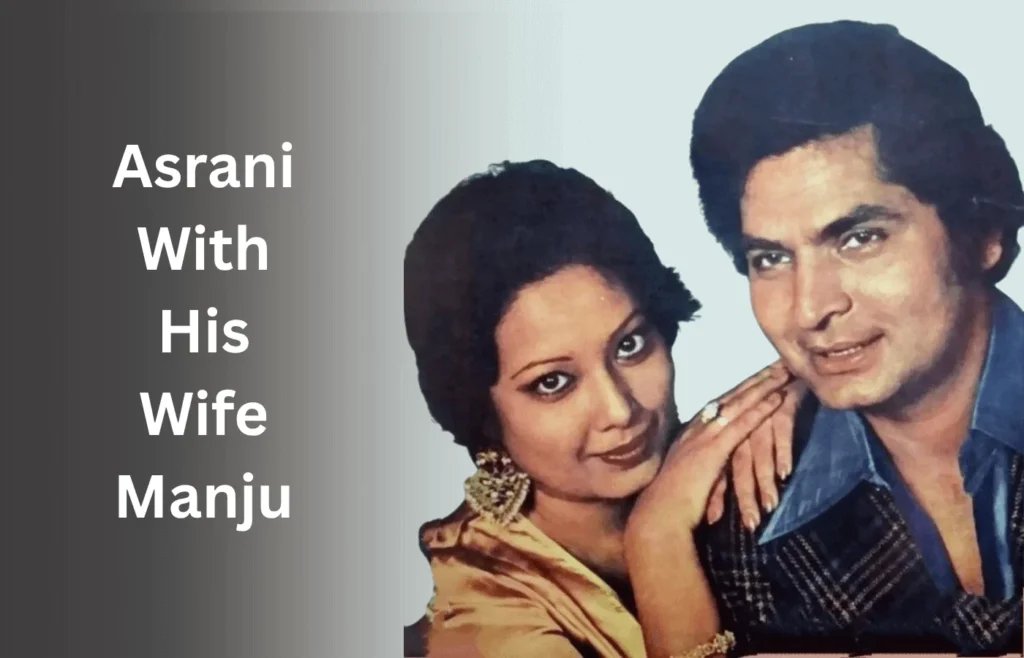
He was married and shared a close bond with his children, making it clear that family always came first despite the demands of his prolific film career. Colleagues often remarked that the same empathy and attentiveness he brought to his roles were evident in his personal interactions — a man who listened, observed, and cared, much like the characters he portrayed on screen.
Traits That Defined Him Away from the Camera
Away from the camera, Asrani was known for his humility, kindness, and gentle humor. Despite decades in Bollywood and sharing screens with some of the biggest stars, he never let fame overshadow his grounded personality. Friends and fellow actors recall that he had an infectious laugh, a sharp wit, and a unique ability to lighten tense situations — qualities that made him beloved not only by audiences but also within the film fraternity.
He was also a man of discipline and dedication. Even in his later years, Asrani approached each project with the same meticulous attention to detail he had shown as a young actor navigating auditions and small roles. This combination of professionalism and approachability earned him respect across generations of actors, directors, and crew members.
Anecdotes That Reveal the Man
Many anecdotes from colleagues and friends reveal a personality as vibrant off-screen as on-screen. During the shooting of Sholay, the cast would often recount how Asrani would improvise lines and gestures between takes, keeping the atmosphere light and creative. His improvisational humor wasn’t just for audiences; it was his way of connecting with people, boosting morale, and fostering camaraderie on set.
Even in his personal life, he was known for small acts of generosity and thoughtfulness. Stories of him mentoring young actors, helping struggling artists find opportunities, or sharing insights from his own early struggles highlight a man who remained grounded, empathetic, and supportive, embodying the human values that were often mirrored in his on-screen roles.
Values That Shaped His Work
Asrani’s personal philosophy — rooted in humility, perseverance, and authenticity — directly influenced his craft. He believed in bringing truth and relatability to every role, no matter how minor. He often emphasized that comedy should not be cruel or mean-spirited; rather, it should reflect life’s quirks and human foibles with warmth.
This approach allowed him to create characters that audiences remembered not just for laughs, but for their heart. His life demonstrated that the best comedy often comes from observing reality with honesty, compassion, and subtlety — a principle he practiced both on and off the screen.
A Life Remembered
When Asrani passed away on 20 October 2025, the film industry and his fans mourned not only the loss of a legendary actor but also of a remarkable human being. His personal values — humility, generosity, professionalism, and kindness — left as much of an imprint as his memorable performances. For colleagues and fans alike, Asrani’s life off-camera was a testament to the fact that true greatness lies in both talent and character, a lesson that continues to inspire anyone who knew him, worked with him, or enjoyed his work.
Final Years & Farewell – Saying Goodbye to a Legend
The Later Years: Sustaining Relevance and Charm
Even in the final decades of his life, Govardhan Asrani remained a vital presence in Indian cinema. Well into the 2000s and 2010s, he continued to appear in films, television shows, and occasional stage performances. Audiences across generations recognized him instantly, whether in a supporting role or a cameo, a testament to the timelessness of his persona.
Films like Hera Pheri (2000), Malamaal Weekly (2006), Bhagam Bhag (2006), and Deewane Huye Paagal (2005) introduced him to younger viewers, while longtime fans continued to cherish his earlier classics. Despite the evolving tastes of cinema, Asrani’s signature humor, expressive timing, and warmth kept him relevant. Directors and co-actors often noted that working with him brought a sense of joy and ease to the set — his presence alone uplifted the energy of any project.
Circumstances of His Passing
On 20 October 2025, the Indian film fraternity and millions of fans across the globe mourned the passing of Govardhan Asrani. At the age of 84, he left behind a legacy that spanned more than fifty years of cinema, encompassing over 350 films and countless memorable performances.
News of his death sparked an outpouring of grief and tributes. Leading actors, filmmakers, and comedians took to social media to honor his contributions, recalling personal stories, on-set moments, and the influence he had on their own careers. Fans shared clips, dialogues, and stills from his films, reflecting on how his laughter had touched their lives for decades. Tributes were not just about celebrating his comedy but also about acknowledging the generosity, humility, and dedication of the man behind the roles.
The Industry and Audience Response
The industry’s response was immediate and heartfelt. Film awards bodies, veteran actors, and directors expressed deep sorrow, emphasizing Asrani’s unique place in Bollywood history. Television channels aired retrospectives of his most beloved performances, while fan groups and cinema enthusiasts held virtual and in-person memorials celebrating his life.
For audiences, Asrani was more than an actor — he was a companion in the cinematic journey of their lives. People who grew up watching his antics remembered him as the actor who could make them laugh and feel simultaneously, a rare combination that few performers achieve.
Reflecting on a Goodbye
Saying goodbye to Asrani was not merely the farewell to a beloved actor; it was the closing of a chapter in Indian cinema that had touched countless lives. His characters had been part of family conversations, school mimicry, and social gatherings, embedding him deeply into popular culture.
The farewell was also a reminder of the power of character actors and the essential role they play in storytelling. While lead stars often dominate the spotlight, it was Asrani who demonstrated that supporting roles — crafted with nuance, heart, and impeccable timing — could leave a lasting cultural and emotional impact.
As fans, colleagues, and the industry grieved, they celebrated a life devoted to laughter, humanity, and art. Govardhan Asrani’s final bow may have marked the end of his earthly journey, but his legacy continues to live on in every frame of his films, every dialogue quoted, and every actor inspired by his craft.
Lessons & Takeaways
Perseverance and Dedication to Craft
One of the most enduring lessons from Govardhan Asrani’s life is the power of perseverance. Starting as a young actor in the 1960s with modest opportunities, he faced the typical struggles of the film industry — long auditions, small roles, and periods of uncertainty. Yet, he never wavered in his commitment to acting.
For writers, performers, and creators, Asrani’s journey illustrates that consistent effort, patience, and resilience can eventually transform persistence into legacy. His career reminds us that every small role, every rehearsal, and every improvisation is a step toward mastery, and even minor contributions can have monumental cultural impact when approached with dedication.
Adaptability Across Eras and Mediums
Asrani’s career spanned five decades, during which the Indian film industry underwent tremendous transformations — from the simplicity of 1970s family comedies to the slapstick and commercial trends of the 1990s and the experimental narratives of the 2000s.
His ability to adapt to changing cinematic tastes, without losing the essence of his craft, is a crucial takeaway for anyone navigating evolving creative spaces. Whether adjusting his comedic timing, embracing different genres, or working with new-generation actors, Asrani demonstrated that adaptability is not just survival; it is a way to remain relevant and influential across generations.
Respect for the Craft and Human Connection
Another key lesson lies in Asrani’s humility and respect for his art. He treated every role with seriousness, no matter how small, and valued the collaborative spirit of filmmaking. By prioritizing authenticity and emotional truth over mere spectacle, he created characters that audiences could relate to and remember.
For readers and creators, his example emphasizes that great work often stems from combining skill with integrity. Whether it is writing, performing, or any creative endeavor, approaching your craft with respect, attention to detail, and empathy for your audience can leave a lasting impact.
Ideas for Reflection and Application
- For performers: Study Asrani’s timing, voice modulation, and facial expressions to understand how subtlety enhances humor and emotional resonance.
- For writers: Analyze the structure of his characters — how supporting roles can carry thematic weight, add narrative depth, and create memorable moments.
- For creators in general: Observe how his adaptability allowed him to thrive across decades; consider applying flexibility and innovation in your own creative projects.
Further Angles to Explore
Asrani’s career offers multiple avenues for deeper exploration:
- A technical deep-dive into his comedic technique, studying how pauses, gestures, and expressions built humor.
- Comparative studies of supporting vs. lead roles, showing how he maximized screen presence without overshadowing main characters.
- Influence on modern comedians and how his style continues to inspire contemporary performances in film, television, and digital media.
- The art of character acting, using his filmography to examine how versatility and authenticity create memorable performances.
Asrani’s journey teaches that lasting impact comes from a combination of talent, dedication, and humanity. He showed that laughter can be both entertaining and reflective, that supporting roles can define cultural memory, and that a genuine love for one’s craft shines through every frame.
His life and work encourage creators of all kinds to embrace perseverance, adaptability, and empathy, and to find joy in the process of creation, knowing that true legacy is built one honest effort at a time.
Conclusion & FAQs
Govardhan Asrani’s life was a remarkable testament to talent, perseverance, and humility. From his early days as a struggling actor to becoming one of Bollywood’s most beloved comedians, his journey spanned over five decades and more than 350 films. His characters — whether the bumbling jailor in Sholay or the witty friend in Chupke Chupke — became cultural icons, leaving a lasting imprint on audiences and inspiring generations of actors and comedians.
Asrani demonstrated that supporting roles, when performed with dedication, skill, and authenticity, can achieve timeless impact. He combined impeccable comic timing with emotional depth, creating characters that were relatable, memorable, and full of heart. Beyond the screen, his humility, mentorship, and professionalism made him a cherished figure within the industry and a model of integrity for creators everywhere.
His passing on 20 October 2025 marked the end of an era, but his legacy endures. Through his performances, anecdotes, and the lessons he imparted, Asrani continues to teach us about perseverance, versatility, and the joy of storytelling. He wasn’t just an actor; he was a cultural treasure whose laughter and warmth will echo across generations.
Frequently Asked Questions (FAQs)
Who was Govardhan Asrani?
Govardhan Asrani, popularly known as Asrani, was a legendary Indian actor and comedian, celebrated for his roles in over 350 films spanning five decades. He is best remembered for his iconic comedic performances in films like Sholay and Chupke Chupke.
When and where was Asrani born?
Asrani was born in Jaipur, Rajasthan, into a middle-class Sindhi family. His early life and upbringing instilled in him values of humility, dedication, and empathy, which shaped both his personal and professional life.
What made Asrani’s comedy distinctive?
Asrani’s comedy was marked by impeccable timing, expressive facial gestures, and subtle humor. Unlike slapstick comedians, he focused on situational comedy and character-driven performances, which made his roles both relatable and memorable.
What were some of Asrani’s most iconic roles?
4.
Some of his standout roles include:
1. The jailor in Sholay (1975)
2. Professor Sukumar in Chupke Chupke (1975)
3. Supporting comedic roles in Gol Maal (1979), Hera Pheri (2000), and Malamaal Weekly (2006)Did Asrani work behind the camera as well?
Yes, Asrani directed and wrote films, including Chala Murari Hero Banne (1977), showcasing his understanding of narrative structure and his ability to bring personal experiences into storytelling.
How did Asrani influence other actors and comedians?
Many modern actors and comedians, including Johnny Lever, Paresh Rawal, and Rajpal Yadav, have cited Asrani’s comic timing, adaptability, and expressive acting as inspiration for their own performances.
When did Asrani pass away?
Govardhan Asrani passed away on 20 October 2025 at the age of 84. His death was widely mourned by fans, colleagues, and the film industry, who celebrated his immense contribution to Indian cinema.
What lessons can aspiring creators learn from Asrani’s life?
His life teaches the value of perseverance, adaptability, respect for one’s craft, and the power of authenticity. Even small roles, when performed with dedication, can leave a lasting impact on audiences and inspire future generations.
Why is Asrani considered a cultural icon?
Asrani’s characters, dialogues, and comedic style became embedded in Indian popular culture. His work continues to be referenced in films, television, mimicry, and social media, making him an enduring symbol of humor and artistry.
How can one explore Asrani’s work further?
Viewers can explore his legacy by revisiting his classic films, analyzing his comic timing and character-building techniques, and studying his contributions to supporting roles and situational comedy in Indian cinema.
